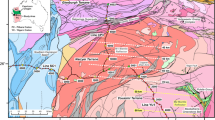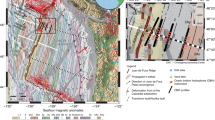Abstract
THE lithosphere—the rigid outer shell of the Earth—includes both the crust and the upper mantle. In the past decade, the complex continental crust and underlying shallower mantle lithosphere have been extensively studied using reflection seismology, but the lower lithosphere has not been successfully imaged. Here we report the observation of continuous and virtually horizontal reflectors in the lower continental lithosphere down to depths of 100–110 km below the Skagerrak (Scandinavia). These are apparently not structurally associated with the crust, whereas previously reported mantle reflectors, such as those observed by the BIRPS group around the British Isles1,2, are often located near large faults in the overlying crust. Like the crust, the mantle lithosphere shows a seismically transparent upper and a reflective lower part. Thus, the processes that form seismic reflectors seem to have an affinity for ductile rheological environments in the mantle as well as in the crust. Our observations are consistent with a model consisting of a mechanically strong upper lithosphere, underlain by a thermal boundary layer which separates it from the convecting asthenosphere.
This is a preview of subscription content, access via your institution
Access options
Subscribe to this journal
Receive 51 print issues and online access
$199.00 per year
only $3.90 per issue
Buy this article
- Purchase on Springer Link
- Instant access to full article PDF
Prices may be subject to local taxes which are calculated during checkout
Similar content being viewed by others
References
Warner, M. & McGeary, S. Geophys. J. R. astr. Soc. 89, 223–230 (1987).
Matthews, D. H. et al. Tectonophysics 173, 387–396 (1990).
Husebye, E. S., Ro, H. E., Kinck, J. J. & Larsson, F. R. Norg. geol. Unders. Spec. Publ. 3, 14–20 (1988).
Klemperer, S. L. Digital Seismology and Fine Modeling of the Lithosphere (Plenum, London, 1989).
Larsson, F. R. & Husebye, E. S. Tectonophysics (in the press).
Klemperer, S. L. J. Geophys. 61, 1–11 (1987).
Flack, C. & Warner, M. Tectonophysics 173, 469–481 (1990).
Smythe, D. K. et al. Nature 299, 338–340 (1982).
Posgay, K., Hegedue, E. & Timar, Z. Tectonophysics 173, 379–385 (1990).
Sawyer, D. S. J. geophys. Res. 90, 3021–3025 (1985).
Fuchs, K. Geophys. J. R. astr. Soc. 49, 167–179 (1977).
Anderson, D. L. Theory of the Earth (Blackwell, Oxford, 1989).
Calcagnile, G. Tectonophysics 90, 19–35 (1982).
Pedersen, T., Pettersson, S. E. & Husebye, E. S. Tectonophysics (in the press).
McKenzie, D. & Bickle, M. J. J. Petrol. 29, 625–679 (1988).
Author information
Authors and Affiliations
Rights and permissions
About this article
Cite this article
Lie, J., Pedersen, T. & Husebye, E. Observations of seismic reflectors in the lower lithosphere beneath the Skagerrak. Nature 346, 165–168 (1990). https://doi.org/10.1038/346165a0
Received:
Accepted:
Issue Date:
DOI: https://doi.org/10.1038/346165a0
This article is cited by
Comments
By submitting a comment you agree to abide by our Terms and Community Guidelines. If you find something abusive or that does not comply with our terms or guidelines please flag it as inappropriate.



